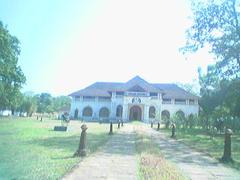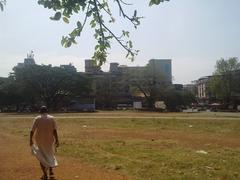Visiting Poomala Dam: Hours, Tickets, and Tips
Date: 01/08/2024
Introduction
Poomala Dam, nestled in the serene landscapes of Thrissur, Kerala, is a hidden gem that offers a blend of historical significance, natural beauty, and modern amenities. With its origins dating back to a division weir constructed in 1939 and the subsequent development of the Poomala reservoir in 1968, the dam has played a crucial role in supporting local agriculture (Wikipedia). Over the years, its picturesque setting has transformed it into an emerging tourist destination, attracting visitors seeking tranquility and a retreat from urban life. Officially recognized as a tourist center in 2010, the dam has since seen significant infrastructure development, including walkways, a community hall, and other visitor facilities (Wikipedia). This comprehensive guide aims to provide detailed information on visiting Poomala Dam, ensuring a well-rounded and enriching experience for all visitors.
Table of Contents
- [Introduction](#introductionintroduction)
- [History and Significance](#history-and-significancehistory-and-significance)
- [Early Construction and Purpose](#early-construction-and-purposeearly-construction-and-purpose)
- [Development as a Tourist Destination](#development-as-a-tourist-destinationdevelopment-as-a-tourist-destination)
- [Official Recognition and Infrastructure Development](#official-recognition-and-infrastructure-developmentofficial-recognition-and-infrastructure-development)
- [Visitor Information](#visitor-informationvisitor-information)
- [Visiting Hours and Tickets](#visiting-hours-and-ticketsvisiting-hours-and-tickets)
- [Travel Tips and Recommendations](#travel-tips-and-recommendationstravel-tips-and-recommendations)
- [Cultural and Ecological Significance](#cultural-and-ecological-significancecultural-and-ecological-significance)
- [Impact on Local Economy and Community](#impact-on-local-economy-and-communityimpact-on-local-economy-and-community)
- [Poomala Dam in Popular Culture](#poomala-dam-in-popular-culturepoomala-dam-in-popular-culture)
- [Geographical and Environmental Context](#geographical-and-environmental-contextgeographical-and-environmental-context)
- [Best Time to Visit](#best-time-to-visitbest-time-to-visit)
- [Nearby Attractions](#nearby-attractionsnearby-attractions)
- [FAQ Section](#faq-sectionfaq-section)
- [Conclusion](#conclusionconclusion)
- [References](#referencesreferences)
History and Significance
Early Construction and Purpose
Poomala Dam, located in the Thrissur district of Kerala, India, has a rich history that dates back to the early 20th century. The initial construction in the Poomala Valley began with a division weir in 1939. This early structure was primarily aimed at supporting the local agrarian communities by providing a reliable source of irrigation. The weir’s success led to the commissioning of the Poomala reservoir in 1968, which further enhanced the region’s agricultural productivity (Wikipedia).
Development as a Tourist Destination
While the dam’s primary purpose was irrigation, its serene environment and picturesque landscape gradually attracted visitors. Initially, tourism was not a significant activity at Poomala Dam, as the area remained largely unexplored and under-advertised. However, the natural beauty of the dam and its surroundings began to draw attention through word of mouth. As eco-tourism and leisure travel gained popularity, Poomala Dam emerged as an offbeat destination for those seeking a peaceful retreat from urban life (Travelsetu).
Official Recognition and Infrastructure Development
The turning point for Poomala Dam as a tourist spot came in 2010 when it was officially designated as a tourist center by the Home Minister of State, Kodiyeri Balakrishnan, on March 21. This official recognition spurred further development of the area to cater to tourists. The District Tourism Promotion Council (DTPC) of Thrissur undertook a significant project in 2008, with an investment of 50 lakh INR, to beautify the dam’s environs. This project included the construction of various facilities such as a 600-meter walkway, a community hall with a capacity of 300 persons, a cafeteria, and latrine facilities (Wikipedia).
Visitor Information
Visiting Hours and Tickets
Poomala Dam is open to visitors throughout the year. The typical visiting hours are from 9 AM to 5 PM. There may be a nominal entry fee, which goes towards the maintenance and development of the area. For the latest information on ticket prices and visiting hours, it is advisable to check with local authorities or the District Tourism Promotion Council (DTPC) of Thrissur.
Travel Tips and Recommendations
When planning a visit to Poomala Dam, it is advisable to check the latest weather forecasts and consult with local authorities or tour operators for any updates on accessibility and dam water levels. Visitors should also be aware that the monsoon season, from June to September, can cause water levels to rise unpredictably, potentially restricting access to certain areas for safety reasons. Despite this, some visitors might find the monsoon-infused beauty of the region appealing, albeit with the necessary precautions (Travelsetu).
Cultural and Ecological Significance
Poomala Dam is not just a tourist attraction but also a symbol of the region’s commitment to maintaining an ecological balance while promoting tourism. The dam is constructed with mud and stone, reflecting traditional building techniques that harmonize with the natural environment. The surrounding lush green hills and the tranquil atmosphere make it an ideal spot for picnics, leisurely walks, and birdwatching. The reservoir formed by the dam provides a soothing backdrop for visitors, enhancing the overall experience (Hi Thrissur).
Impact on Local Economy and Community
The development of Poomala Dam as a tourist destination has had a positive impact on the local economy. The influx of tourists has created new livelihood opportunities for the local community, ranging from hospitality services to guided tours and local crafts. The government’s focus on digital marketing through social media platforms has significantly increased awareness about Poomala Dam, attracting more visitors and boosting the local economy (Travelsetu).
Poomala Dam in Popular Culture
The picturesque setting of Poomala Dam has also made it a popular shooting location for movies and television serials. The serene atmosphere and natural beauty of the dam have attracted filmmakers, further enhancing its visibility and appeal as a tourist destination (Hi Thrissur).
Geographical and Environmental Context
Situated 94.50 meters above mean sea level, Poomala Dam is strategically located to harness the water resources of the Manali River, a tributary of the Chalakudy River. The dam’s construction has played a crucial role in managing water resources for irrigation, ensuring the sustainability of agricultural practices in the region. To the north of Poomala Dam lies another dam, Pathazhakundu, which is currently oriented solely for irrigation purposes (Wikipedia).
Best Time to Visit
The best time to visit Poomala Dam is during the post-monsoon months from October to March. During this period, the weather is relatively cool and comfortable, with average temperatures ranging from 23°C to 32°C. The monsoon rains have ceased, leaving the landscape lush and green, and the water levels in the dam are optimal. This time is ideal for photographers and nature lovers to capture the picturesque surroundings and for families to enjoy picnics by the water. Additionally, the months of December and January can be particularly delightful, with the possibility of witnessing local festivals and cultural events in and around Thrissur (Travelsetu).
Nearby Attractions
In addition to Poomala Dam, visitors can explore several nearby attractions in Thrissur. These include the Athirapally Waterfalls, Peechi Dam, and the famous Vadakkunnathan Temple. Each of these sites offers unique experiences and adds to the richness of a visit to Thrissur.
FAQ Section
What are the visiting hours for Poomala Dam?
Poomala Dam is typically open from 9 AM to 5 PM daily.
How much do tickets to Poomala Dam cost?
There may be a nominal entry fee. Please check with local authorities or the DTPC of Thrissur for the latest ticket prices.
What is the best time to visit Poomala Dam?
The best time to visit is from October to March when the weather is pleasant and the landscape is lush and green.
Conclusion
Poomala Dam’s transformation from a purely functional irrigation structure to a cherished tourist destination highlights the region’s ability to balance ecological sustainability with economic development. Its rich history, cultural significance, and natural beauty make it a must-visit location for anyone traveling to Thrissur, Kerala. The ongoing efforts to promote and maintain the dam as a tourist spot ensure that it will continue to provide a serene escape for visitors while supporting the local community.



